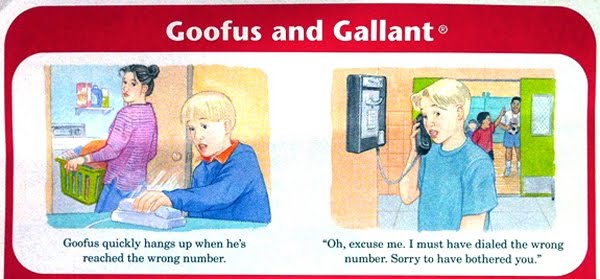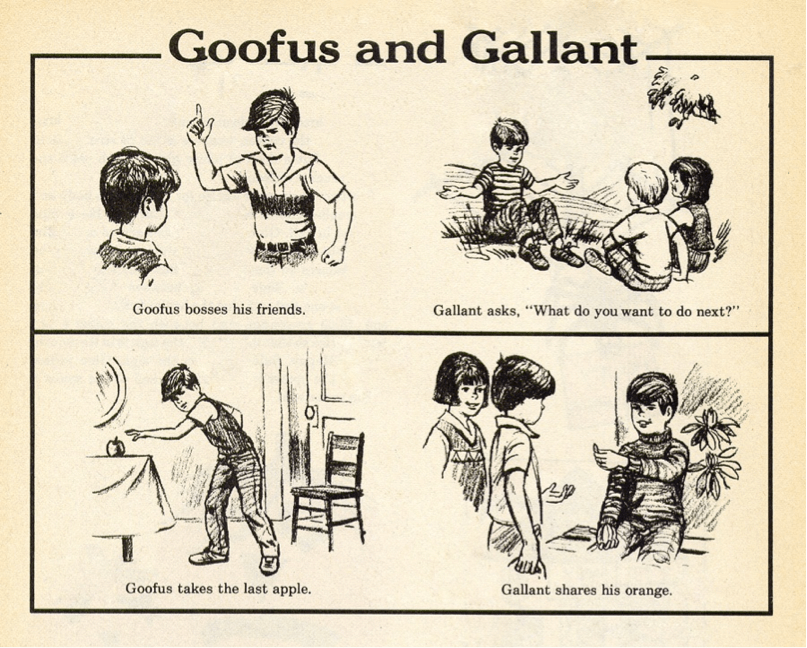If you grew up before about the mid 1980’s, you likely remember the magazine, Highlights for Children (now an online publication, Highlights for Kids) and within that magazine you likely recall a cartoon strip regular feature called Goofus and Gallant. The basic premise is that it features two contrasting boys, Goofus and Gallant. Each cartoon shows how two boys would respond given the same situation. Goofus chooses an irresponsible path, while Gallant is kinder and does things what would please both Miss Manners and Emily Post. The online version still exists today, and readers are even encouraged to submit their own “Goofus and Gallant Moments.”
The strip usually goes something like this – Goofus hogs his seat – Gallant makes space for someone else to sit down. Sometimes the situations would show the boys talking, such as phone courtesy when parents are away: Goofus: “Someone called but I forgot their name.” Gallant: “Someone called for you. I wrote down their name and number”. Goofus and Gallant’s primary function is to teach basic social skills and since it did not come from adults, there was some hope the children reading would take the lesson to heart. You get the idea -you can rest assured that Goofus has been screwing up royally for decades. Given the condition of the world today maybe we need to remember Goofus and Gallant, because the Goofus to Gallant ratio in business and society overall is disproportionately leaning towards more Goofus’ overall.
But what does this have to do with the “Internet of Things”? It seems that non-technical business money people have a love affair with the latest catch phrases, and companies who know this start using the buzzwords and catch phrases to gain favor with Wall Street and “money people”. History is replete with examples.year’s ago, if a radio had more tubes it was considered better. If a heavy TV had a handle it was “portable”. When transistors were first used in radios, extra transistors would be added but not connected to anything because a “6 transistor radio” was thought to be better than 4 – “how many transistors do you have in there?”
Now we have had many examples such as ICs; anything that was microprocessor controlled or digital was better such as mixed signal, thin clients, SAS, Smart Grid, the cloud and on and on. Now we have the “The Internet of Things” or IoT, and Wall Street and marketing people have latched onto this like a Chihuahua on a meatball. Today it seems that anyone offering a product or component is releasing it to support the IoT.
Take a careful look at new product announcements coming out and you will see anything from embedded boards and micro-controllers, to wire-wound resistors, relays, inductors, ceramic capacitors and epoxy resins developed expressly to support the IoT. These products were likely in the product pipeline anyway, but when the new buzzword took hold the opportunity to provide extra excitement to the financiers was uncontrollably compelling, so the press releases are custom tailored to make best use of the latest trends to promote these products.
What could go wrong when advanced technology is put in the hands of humans after all? Soon, it seems that my cappuccino machine working together with the global network of hands-free toilet flush valves will alert my insurance company about my liquid caffeine intake and resulting output ratios to better assist them on assessing their risk and determining my premiums and suitable coverage plans. This will work at least until hackers decide to simultaneously flush all free world nations toilets at once taking down our water grid, overloading our sewers – causing sewer tsunami and bringing us to our knees.
In reality, the IOT is simply an evolutionary application of the connective technology we have been putting in place for a long time, along with the networks we have been building to take advantage of what we can do with all this combined, with sensor technology, which has been in development for some time as well. Nothing really happened overnight to drop this on our doorstep. Everyone can calm down a bit.
I’m sure we will see more of this in the future for other technologies, but this IOT thing is just engineers building new capabilities on top of what we have already been doing in an evolutonary manner over the long haul. Sorry, money guys, nothing really gets invented in a quarter and grows like a hockey stick out of thin air – well OK maybe nothing but social media.
In any case I think we need to bring back Goofus and Gallant. I think Goofus will say that his new line of Philips screwdrivers is optimized for the IoT and try to get a premium for them. Meanwhile Gallant is honest about his products’ features and capabilities: “this embedded controller board has an Ethernet interface and you can choose to use it or not it’s a standard feature- no extra charge.”
As we deploy these connected systems we need more Gallants who have the wisdom to properly use them for good and not nefarious purposes. More Gallant’s who are managers of the technical teams who make all the magic really happen and have been all along. And I’m pretty sure that Goofus will grow up to be a hacker, if he does not kill himself by playing with the electrical service in the neighborhood while trying to steal the copper. If he does survive, we will likely seen him on Jerry Springer a few times. Lets be more like Gallant and treat each other nicely and like we would like to be treated. ~ K. Parmenter



















